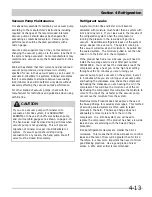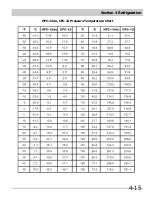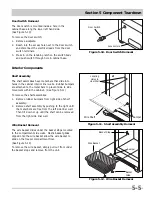
Section 5 Component Teardown
5-9
Figure 5-22. Filter-Drier Removal
Cut Here
Cut Here
Compressor Area Components
Power Cord Removal
The power cord enters the compressor area on the lower
left side and is secured to the compressor mounting
plate with a P-clamp and screw.
To remove the power cord:
1. Pull unit from its installation position to access the
rear compressor area.
2. Using a phillips head screwdriver, extract the four
screws securing the compressor area shield to the
rear of the unit. Remove shield.
3. Using a 1/4” socket or wrench, extract the screw
securing the P-clamp to the compressor mounting
plate. (See Figure 5-21)
4. Using a 1/4” socket or wrench, extract the screw
securing the ground wires to the compressor
mounting plate.
5. Disconnect power cord from the wire harness at the
quick disconnect. Remove power cord from unit.
Filter-Drier Removal
The filter-drier is located in the compressor area on the
left side of the compressor. (See Figure 5-22)
To remove the filter-drier:
1. Pull unit from its installation position.
2. Extract the screws securing the fiber board cover to
the unit frame and remove from unit.
3. Recover refrigerant by using EPA approved
recovery system.
4. Using a 3 cornered file, score a groove around
capillary tube as close to old filter-drier as possible.
Break capillary tube along score mark from
filter-drier.
5. Cut condenser outlet tube at filter-drier. Discard
filter-drier.
6. Thoroughly clean condenser outlet tube and
capillary tube.
7. Place inlet connection of filter-drier over condenser
tube approximately ¼” and solder.
8. Insert capillary tube input end into filter-drier outlet.
Do not allow tube to bottom against screen. Solder
carefully so that solder does not plug capillary tube.
9. Install process tube adapter to filter-drier.
10. Evacuate and charge system using the recommend-
ed procedure described under Evacuating and
Recharging in the Refrigeration section.
11. Reassemble unit.
Figure 5-21. Power Cord Removal
Electrical
Connection
Ground
Screw
P-Clamp
and Screw
On R-134a systems, the system must NOT be left
open to the atmosphere for more than 10 minutes to
prevent moisture contamination of compressor oil.
CAUTION
Summary of Contents for FFH17F8HW0
Page 2: ......
Page 14: ...Section 2 Installation Information 2 6 Notes ...
Page 18: ...Section 3 Electronic Control 3 4 Notes ...
Page 33: ...Section 4 Refrigeration 4 15 HFC 134a CFC 12 Pressure Temperature Chart ...
Page 36: ...Section 4 Refrigeration 4 18 Notes ...
Page 48: ...Section 5 Component Teardown 5 12 Notes ...
Page 53: ...Section 7 Wiring Diagram 7 1 ...










































